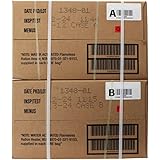Understanding Your Situation
Assessing Possible Scenarios
Before diving into any preparation, I always take a step back and look at possible situations. It’s like preparing for a storm; you wouldn’t just grab an umbrella without checking the weather first. Whether it’s due to natural disasters, economic changes, or personal circumstances, understanding what you might face is crucial.
Once I’ve forecasted a couple of scenarios, I think about the duration of these situations. Long-term displacement doesn’t just mean a weekend at a relative’s house. I consider scenarios where I might be away for months, or even longer, and that kicks my planning into high gear.
Lastly, I begin to visualize life during these scenarios. How would I get to work? What about my kids’ schooling? These thought processes help me frame my preparations more concretely and practically.
Setting Priorities
When I think about what’s most important during displacement, I prioritize my basic needs: Food, shelter, and safety. Next up is communication. Being connected to my support network is super important; it helps me feel less isolated and more empowered.
I also work on thinking about emotional support. Long-term displacement can really take a toll on your mental health. So, I make a list of friends, family, or even counselors I can reach out to. Sometimes just having someone to chat with makes all the difference.
Finally, I try to think about what I might need to keep up with my daily life, like school or work. Finding a way to continue those routines, even in a new environment, can tremendously ease the transition.
Creating a Solid Plan
Emergency Supplies
Gathering emergency supplies is a critical step I never overlook. I usually curate a list of essentials like food, water, first aid kits, and personal documents. It’s like building a mini survival kit that I can easily grab and go, and it gives me peace of mind knowing I have backup in case things get messy.
Next, I focus on practicality. I include things that my family specifically loves, like snacks that don’t need refrigeration—because, let’s be honest, when the mood strikes, a granola bar is much better than a can of beans!
== > What if ... Get a FREE Subscription to PREPARE
Lastly, I make sure to check these supplies regularly. Expiration dates can sneak up on you, and there’s nothing worse than finding out that the emergency granola bars you stowed away five years ago aren’t edible anymore!
Communication Tools
Your communication plan is just as vital as your emergency supplies. I always have a list of contacts written down, not just saved on my phone. In a crisis, things can go haywire, and having a good ol’ paper list is super handy.
Texting and social media can often fail in disasters, so I consider alternatives like walkie-talkies or ham radios. It sounds a bit old-school, but they can really save the day in a pinch.
Lastly, I set up a “meeting spot” with my family and friends. This is our designated place to rendezvous if things get tough. Knowing where to go if communication gets cut off can soothe those anxieties that tend to bubble up during tough times.
Logistics of the Move
Finding Housing
One of the biggest challenges is finding housing in a new area, and I’ve definitely been down that road before. I usually start by researching various options online—Airbnb, local listings, or even reaching out to local community boards. Every little bit helps.
When I find a place, I try to get a lay of the land. Are there grocery stores nearby? Schools? Parks? Understanding my new neighborhood can help me adapt faster.
Lastly, I think about the duration of my stay. Is this going to be temporary or more of a long-haul situation? Knowing this can dictate the kind of housing I seek out, whether it’s a cozy apartment or just a room in someone’s home.
Get Preparedness and Self-Reliance Tips. Subscribe Now!
Transportation Considerations
Transportation is another biggie. I consider whether I can drive, or if public transport is accessible. If I’m driving, I check my vehicle’s condition and maybe even make a plan for a roadside assistance service, just in case.
Furthermore, I connect with local transport options. If I’m in a bustling city, I might opt for a subway pass, whereas in a quieter area, a reliable bike might do the trick. Knowing these options in advance makes a big difference.
Lastly, I think about travel expenses. If I’m going to be traveling often during my displacement, budgeting for those transport costs is key. I keep a little extra set aside just in case something pops up!
Emotional and Mental Preparation
Building a Support Network
Long-term displacement can leave you feeling isolated, so I actively work on building a support network. I connect with local community centers, social media groups, or even local clubs that match my interests. It’s amazing how a shared hobby can lead to deep connections.
Once I find these groups, I prioritize attending meet-ups or events. Just putting myself out there—even if it feels a bit uncomfortable—can lead to lifelong friendships.
Additionally, I make a point to keep up with friends and family back home. Regular video calls and meetups can help remind me of my roots, making a difference in how I cope with the transition.
Maintaining Mental Health
Taking care of my mental health is a priority throughout this process. I actually set a routine that includes self-care practices, like exercise, journaling, or even meditation. These small rituals stabilize my emotional well-being amidst chaos.
I also seek professional help if I feel the need. Finding a therapist who understands displacement can do wonders for processing emotions. Honestly, seeking help isn’t a sign of weakness; it’s a step toward strength!
Finally, I remind myself to take breaks. I’ll allow myself some downtime to just relax and recharge. Coping with displacement is a marathon, not a sprint, and I always keep that in mind.
Frequently Asked Questions
What should I include in my emergency supplies?
Your emergency supplies should include essentials like non-perishable food, water, personal documents, a first aid kit, and any necessary medications. Don’t forget comfort items, too, like snacks or books!
How do I find housing during long-term displacement?
Research various options online, such as Airbnb, local listings, and community boards. Visit potential housing options if possible, and make sure to understand your neighborhood’s amenities.
What are good communication tools during displacement?
Aside from your mobile phone, keep a list of contacts written down. Alternative communication methods like walkie-talkies or ham radios are handy, especially if traditional means fail.
How can I build a support network in a new area?
Explore local community centers, social media groups, and clubs that match your interests. Attend events and meet-ups to connect with others in your area.
What are some self-care practices for maintaining mental health during displacement?
Establish routines that include activities like exercise, journaling, or meditation. Consider seeking professional help if needed, and allow yourself downtime to recharge.






